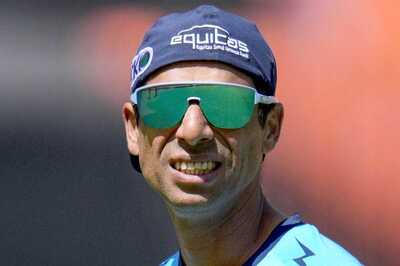
views
Apple Watch Calorie Accuracy
The Apple Watch is somewhat accurate at measuring calories burned. Studies have found that no wearable fitness tracker is completely accurate when measuring calories burned (also called energy expenditure). A 2017 study by researchers at Stanford University found that the Apple Watch was one of the more accurate trackers available to consumers, but that doesn't mean it's 100% accurate with no room for error. Anecdotally, some Apple Watch users have found the watch to be incredibly accurate (with almost no deviation from actual calories burned) or less accurate (with a deviation of 100 to 200 calories compared to actual calories burned). The accuracy of the Apple Watch varies depending on a few factors: Statistics: You must enter your height, weight, age, and a number of other body stats into your Apple Watch when setting it up. If these values are off, it can make the Apple Watch less accurate at calculating calories burned. Watch tightness: If your watch is too loose, it won't be able to accurately measure your vitals, which means the calculations your watch does to figure out calories burned won't be accurate either. Skin color: Some studies have found that people with darker skin tones may not get as accurate of reading with the Apple Watch. This is because the Apple Watch uses an LED light to measure your vitals which are then used to calculate calories burned, but melanin affects how skin absorbs light. However, the studies were not conclusive, and some studies found that skin color didn't have any effect on the Apple Watch's accuracy.
How the Apple Watch Calculates Calories
Calories burned are calculated with your vitals and movement. Your Apple Watch measures your heart rate using the light sensor on the back of the watch. The accelerometer inside the watch measures your speed and movement. Your Apple Watch takes this information along with what type of workout you're doing (specified in the Workout app) and uses algorithms to calculate your approximate calories burned. Apple has not disclosed how these algorithms work or what calculations the Apple Watch does to figure out energy expenditure.
How to Increase Apple Watch Accuracy
Update your health data. Keeping your health statistics up to date is the best way to ensure your Apple Watch is accurately calculating calories burned. To update your health data, follow these steps: Open the Watch app on your iPhone. Tap My Watch. Go to Health > Health Details. Tap Edit. Tap the item(s) you want to change. Enter in the new information. Tap Done when you're finished.
Turn on Wrist Detection. If you've disabled Wrist Detection on your Apple Watch, your watch won't be able to measure your heart rate, which is necessary to calculate calories burned. To turn on Wrist Detection, follow these steps: Open the Watch app on your iPhone. Tap My Watch. Tap Passcode. Toggle on Wrist Detection.
Tighten your watch. If your watch is too loose, the sensor on the back won't be able to measure your heart rate properly. According to Apple, your watch should be snug against your wrist, with the sensor on the back in contact with your skin. The best way to achieve this is to wear the watch above your wrist bone.
Calibrate your Apple Watch. If your Apple Watch is not calibrated, it may not be as accurate as possible. To calibrate your watch, follow these steps: Open the Settings app on your iPhone. Go to Privacy & Security > Location Services. Ensure Location Services is toggled on. Tap on System Services. Ensure Motion Calibration & Distance is toggled on. Put on your Apple Watch. Go to a flat outdoor space that gets good reception and has clear skies. If you have an Apple Watch Series 1, you'll need your iPhone with you for GPS capabilities. If you have the Apple Watch Series 2 or later, you just need the watch. Open the Workout app on your watch. Tap Outdoor Walk or Outdoor Run. You can set a goal before starting by tapping the three-dot icon, but this is optional. Walk or run (depending on the workout you chose) at your normal pace for 20 minutes. Whenever you do a 20-minute Outdoor Walk or Outdoor Run through the Workout app, your Apple Watch will continue to calibrate to learn your stride length at various speeds. This continual calibration will make the watch's calorie calculations more accurate, according to Apple.
Choose the right workout. When using the Workout app, pick the workout that best fits what activity you're doing for exercise. If you choose an Outdoor Run workout, your watch will be expecting your heart rate, stride length, and movement speed to make sense for that activity. If you end up doing an indoor walk instead, the Watch may not be able to collect and display accurate data for you.
Apple Watch Alternatives
A different fitness tracker One alternative to the Apple Watch is a different fitness tracker. There are a ton of fitness trackers on the market, and many of them are much cheaper than the Apple Watch. This is a great option if you're in the market for a fitness tracker and you're not too concerned about how accurate the calorie data is. There are tons of fitness trackers on the market, with new devices being released every year. Some of the most reputable brands, however, include Fitbit, Garmin, Samsung, and WHOOP.
Activity tracking app or calculator Instead of using a fitness tracker that you wear, you can try using a calculator or activity tracker. You can find these calculators and/or trackers online, or you can download an app on your phone. However, these methods also won't be 100% accurate, as they use standardized data based on the "average" person. Some online energy expenditure calculators include Calculator.net, WebMD, and Mayo Clinic. Some apps that include energy expenditure calculators include MyFitnessPal and Lose It.
Math You can also do the math yourself with a pencil and paper (or a calculator, of course!) if you prefer. However, note that this will also only be an estimate, as the equation used to calculate calories burned uses MET (metabolic equivalent), which is standardized and generic so it can be used by many groups of people. First, get your body weight in kilograms. If you only have a scale that weighs in pounds, convert it to kg first. You can do this with Google, or by multiplying your weight in pounds by 0.45. Example: If you weigh 200 lbs, you weigh about 90 kg. Next, find the MET value of your exercise. To do this, go to https://pacompendium.com and choose Adult Compendium, Older Adult Compendium, or Wheelchair Compendium depending on which fits you best. Then, choose a category and find your activity in the chart. Go with the option that fits your activity best. Example: If you went for a hike that was mostly level and you weren't carrying heavy equipment with you, you'd use the MET value of "Hiking or walking at a normal pace through fields and hillsides, no load" for 5.3 METs. Then, calculate calories burned per minute. The formula is METs x 3.5 x [body weight in kg] / 200. Example: If you weigh 90 kg and did an activity that has an MET value of 5.3, the formula would be 5.3 x 3.5 x 90 / 200, which comes out to about 3.35 calories burned per minute. Finally, multiply the result of the MET formula by how many minutes you did the activity. This will give you a good estimate of how many calories you burned doing the activity or workout. Example: If you hiked for 1 hour (60 minutes), you would multiply 8.35 x 60 to get a total of 501 calories burned during the entire hike.
Key Takeaways
Update your Apple Watch health info. If you already own an Apple Watch and want to get the most accurate data possible, make sure your health info is up to date. Check your health data every few months to update your weight if you've gained or lost any, and update your age once a year.
Use your Apple Watch data as a guideline. Since your Apple Watch isn't 100% accurate at measuring calories burned, don't use the data super strictly. Instead, use it as a guideline to see approximately how much you've burned in a day, give or take 100 to 200 calories.
Speak to a doctor if you need more accurate data. If you need to measure your energy expenditure more accurately, speak to your doctor. They can provide you with all the options that are available to you, as well as advise you on which method they want you to use to track calories burned. You can also ask your doctor about the possibility of going to a sports lab for accurate tracking.
Try an alternative way to measure calories burned. If you don't have an Apple Watch or you want to try a different way to measure your calories burned, try a different fitness tracker, use an online calculator or activity tracker app, or use some math to figure it out on paper.




















Comments
0 comment